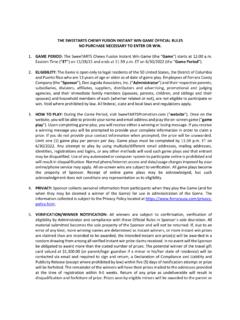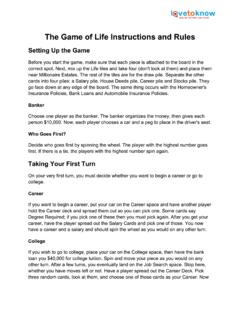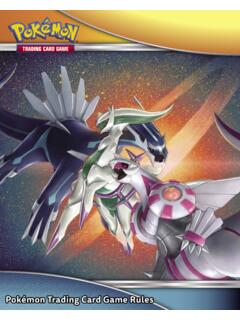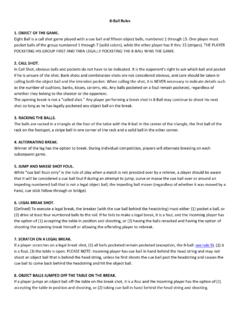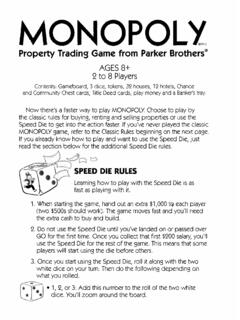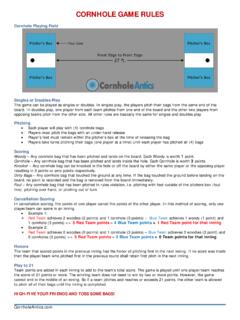Transcription of 7 GAME RULES: ROBOTS
1 7 game rules : ROBOTS V7 49 of 136 7 game rules : ROBOTS The 2022 FRC Game Manual implements updated methods for identifying rule numbers and recurring rules . See Section This Document & Its Conventions for details. ROBOT Restrictions G101 *Dangerous ROBOTS : not allowed. ROBOTS whose operation or design is dangerous or unsafe are not permitted. Violation: If before the MATCH, the offending ROBOT will not be allowed to participate in the MATCH. If during the MATCH, the offending ROBOT will be DISABLED. Examples include, but are not limited to: a. uncontrolled motion that cannot be stopped by the DRIVE TEAM, b. ROBOT parts flailing outside of the FIELD, c. ROBOTS dragging their battery, and d. ROBOTS that consistently extend beyond the FIELD. G102 * ROBOTS , stay on the FIELD during the MATCH. ROBOTS and anything they control, CARGO, may not contact anything outside the FIELD except for MOMENTARY incursions into the TERMINAL and MOMENTARY contact with the CHUTE.
2 Violation: DISABLED. Please be conscious of REFEREES and FIELD STAFF working around the ARENA who may be in close proximity to your ROBOT. G103 *Keep your BUMPERS low. BUMPERS must be in the BUMPER ZONE (see R402) during the MATCH. Violation: FOUL. If REPEATED or greater than MOMENTARY, DISABLED. G104 *Keep your BUMPERS together. BUMPERS may not fail such that a segment completely detaches, any corner (as defined in R401) of a ROBOT S FRAME PERIMETER is exposed, or the team number or ALLIANCE color are indeterminate. Violation: DISABLED. G105 *Keep it together. ROBOTS may not intentionally detach or leave parts on the FIELD. Violation: RED CARD. G106 Tall ROBOTS in HANGAR ZONE only. ROBOT height, as measured when it s resting normally on a flat floor, may not exceed the maximum STARTING CONFIGURATION height (4 ft. 4 in. (~132 cm)) unless any part of the ROBOT S BUMPERS is in its HANGAR ZONE, in which case its height may not exceed 5 ft.
3 6 in. (~167 cm). Violation: FOUL. TECH FOUL if the over-extension blocks an opponent s shot, scores a CARGO, or is the first thing that contacts CARGO exiting from an UPPER EXIT. If the over-extension enables HANGAR points, the ROBOT is no longer eligible for HANGAR points. This measurement is intended to be made as if the ROBOT is resting on a flat floor, not relative to the height of the ROBOT from the FIELD carpet. 7 game rules : ROBOTS V7 50 of 136 For example, a ROBOT that is at an angle while driving over something may actually exceed the height limit when compared to the carpet of the FIELD. Figure 7-1 ROBOT height example G107 Don t overextend yourself. ROBOTS may not extend more than 16 in. (~40 cm) beyond their FRAME PERIMETER. Violation: FOUL. TECH FOUL if the over-extension blocks an opponent s shot, scores a CARGO, or is the first thing that contacts CARGO exiting from an UPPER EXIT.
4 If the over-extension enables HANGAR points, the ROBOT is no longer eligible for HANGAR points. Examples of compliance and non-compliance of this rule are shown in Figure 7-2. Yellow bars represent the limits of the FRAME PERIMETER and are drawn in the same orientation of the ROBOT S FRAME PERIMETER. Green bars represent a measured extension from the FRAME PERIMETER that does not exceed the limit defined in this rule. Red bars represent a measured extension from the FRAME PERIMETER that exceeds the limit in this rule. ROBOTS A and C violate this rule, whereas ROBOT B does not. Figure 7-2 Examples of compliance and non-compliance of this rule G108 Not too high. A ROBOT may not position itself such that any part of its BUMPERS is higher than the HIGH RUNG for a greater than MOMENTARY period of time. Violation: ROBOT is ineligible for any HANGAR points.
5 G109 Avoid the PURPLE PLANE. ROBOTS may never extend beyond the PURPLE PLANE. Violation: DISABLED. 7 game rules : ROBOTS V7 51 of 136 ROBOT to ROBOT Interaction G201 *Don t expect to gain by doing others harm. Strategies clearly aimed at forcing the opponent ALLIANCE to violate a rule are not in the spirit of FIRST Robotics Competition and not allowed. Rule violations forced in this manner will not result in an assignment of a penalty to the targeted ALLIANCE. Violation: FOUL. If REPEATED, TECH FOUL. G201 does not apply for strategies consistent with standard gameplay, for example a red ALLIANCE ROBOT in their HANGAR ZONE in the final 30 seconds of the MATCH contacts a blue ALLIANCE ROBOT. G201 requires an intentional act with limited or no opportunity for the team being acted on to avoid the penalty, such as: a. forcing the opposing ROBOT to have greater-than-MOMENTARY CONTROL of 3 CARGO or b.
6 A ROBOT raising an extension to touch their MID RUNG as an opponent is about hit them with no intention to actually climb G202 *There s a 5-count on PINS. ROBOTS may not PIN an opponent s ROBOT for more than 5 seconds. A ROBOT is PINNING if it is preventing the movement of an opponent ROBOT by contact, either direct or transitive (such as against a FIELD element). A ROBOT is considered PINNED until the ROBOTS have separated by at least 6 ft. (~183 cm) from each other, either ROBOT has moved 6 ft. from where the PIN initiated, or the PINNING ROBOT gets PINNED, whichever comes first. The PINNING ROBOT(S) must then wait for at least 3 seconds before attempting to PIN the same ROBOT again. Violation: FOUL, plus an additional TECH FOUL for every 5 seconds in which the situation is not corrected. A team s desired direction of travel is not a consideration when determining if a ROBOT is PINNED.
7 If the PINNING ROBOT gets PINNED, the original PIN count terminates. Otherwise, if a ROBOT re-PINS the same ROBOT before the 3 seconds referenced in the last sentence of this rule, the REFEREE S count resumes from the initial PIN (versus starting at 0). G203 *Don t collude with your partners to shut down major parts of game play. 2 or more ROBOTS that appear to a REFEREE to be working together may not isolate or close off any major element of MATCH play. Violation: TECH FOUL, plus an additional TECH FOUL for every 5 seconds in which the situation is not corrected. Examples of violations of this rule include, but are not limited to: a. fully blocking all access to either TERMINAL, b. shutting down access to all opponents CARGO, c. quarantining all opponents to a small area of the FIELD, and d. blocking all access to the opponents HANGAR.
8 A single ROBOT blocking access to a particular area of the FIELD is not a violation of this rule. 7 game rules : ROBOTS V7 52 of 136 2 ROBOTS independently playing defense on 2 opponent ROBOTS is not a violation of this rule. Note, G204, G205, and G206 are mutually exclusive. A single ROBOT to ROBOT interaction which violates more than 1 of these rules results in the most punitive penalty, and only the most punitive penalty, being assessed. G204 *Stay out of other ROBOTS . A ROBOT may not use a COMPONENT outside its FRAME PERIMETER (except its BUMPERS) to initiate contact with an opponent ROBOT inside the vertical projection of that opponent ROBOT S FRAME PERIMETER. Contact with an opponent in an opening of their BUMPERS or in the space above the BUMPER opening are exceptions to this rule. Violation: FOUL. For the purposes of G204, initiate contact requires movement towards an opponent ROBOT.
9 In a collision, it s possible for both ROBOTS to initiate contact. G205 *This isn t combat robotics. A ROBOT may not damage or functionally impair an opponent ROBOT in either of the following ways: A. deliberately, as perceived by a REFEREE. B. regardless of intent, by initiating contact inside the vertical projection of an opponent ROBOT S FRAME PERIMETER. Contact between the ROBOT S BUMPERS or COMPONENTS inside the ROBOT S FRAME PERIMETER and COMPONENTS inside an opening of an opponent s BUMPERS is an exception to this rule. Violation: TECH FOUL and YELLOW CARD. If opponent ROBOT is unable to drive, TECH FOUL and RED CARD FIRST Robotics Competition can be a full-contact competition and may include rigorous game play. While this rule aims to limit severe damage to ROBOTS , teams should design their ROBOTS to be robust. The exception in G205-B effectively means that ROBOTS with BUMPER gaps are at their own risk regarding damaging contact in these areas.
10 Examples of violations of this rule include, but are not limited to: a. A ROBOT leaves an arm extended, spins around to change course, and unintentionally hits and damages a COMPONENT inside the FRAME PERIMETER of a nearby opponent ROBOT. b. A ROBOT, in the process of trying to quickly reverse direction, tips up on a single pair of wheels, lands atop an opponent ROBOT, and damages a COMPONENT inside that opponent s FRAME PERIMETER. c. A ROBOT high-speed rams and/or repeatedly smashes an opponent ROBOT and causes damage. The REFEREE infers that the ROBOT was deliberately trying to the damage the opponent s ROBOT. Examples of functionally impairing another ROBOT include, but are not limited to: d. opening an opponent s relief valve such that the opponent s air pressure drops and e. powering off an opponent s ROBOT (this example also clearly results in a RED CARD because the ROBOT is no longer able to drive).










